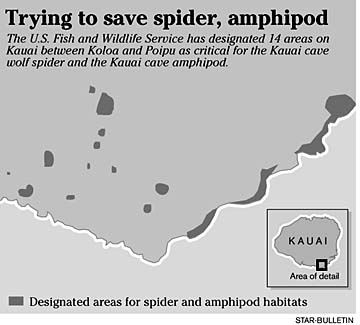
LIHUE >> The U.S. Fish and Wildlife moved yesterday to slash the amount of land it wants to designate as critical habitat for two small, sightless creatures found only in caves on the southern coast of Kauai. U.S. cuts critical habitat
for 2 tiny Kauai crittersBy Anthony Sommer
tsommer@starbulletin.com"Critical habitat" means the area is considered essential for the survival of a species of animal or plant. The Fish and Wildlife Service is required by federal law to designate critical habitat for endangered species.
In November the agency proposed designating 4,193 acres as critical habitat for the Kauai cave wolf spider and the Kauai cave amphipod, which have been seen by only a handful of biologists. The original proposed critical habitat is right in the path of planned major development on Kauai's South Shore.
The Fish and Wildlife Service estimated the designation would result in direct losses of up to $62.3 million (mostly in decreased land values) and indirect losses of up to $1.5 billion (primarily from tourist spending that would not occur) over the next 18 years.
The final decision, published yesterday in the Federal Register, cut the land to 272 acres. Direct losses to landowners were estimated at a maximum of $429,000, and indirect losses, a maximum of $6.1 million.
Remaining within the critical-habitat designation is the Mahaulepu coast. For more than 30 years, the area has been what Hawaii Sierra Club Director Jeff Mikulina terms "a classic environmental battleground" between developers wanting to build a resort and a coalition of environmental groups and preservationists.
Mahaulepu belongs to Grove Farm, which was sold two years ago by the descendants of founder George Wilcox to Steve Case, outgoing chairman of AOL/Time Warner. Grove Farm has repeatedly proposed building a major resort at Mahaulepu. But requests for the required rezoning and building permits all have been turned down by Kauai County.
The "critical habitat" designation applies only to projects built by the federal government or that use federal funds. It requires only that development be designed to prevent harm to the cave-dwelling animals.
"It doesn't apply to a private developer using private funds to build on private land," Mikulina noted. But, he added, "We hope it sends a strong message to local government-permitting authorities that the area should not be disturbed."
The Sierra Club was a key player in a federal court lawsuit that forced the Fish and Wildlife Service to designate critical habitat for endangered animal and plant species in Hawaii.
Mahaulepu is the only area where scientists have seen the two creatures. All other locations are potential habitats.
The critical habitat land lies between Koloa -- site of the first sugar mill in Hawaii -- and the Poipu resort district. The three major landowners -- Grove Farm, Alexander & Baldwin and the Knudsen Trust -- all have plans to build resorts and residential communities.
Grove Farm is still the largest single landowner in the remaining 272 acres. "I cannot comment on the decision," Grove Farm Vice President Allan Smith said yesterday.
The Kauai wolf spider and the Kauai amphipod -- a shrimplike creature -- were discovered in 1971 by Bishop Museum researchers. Both live in lava tubes and limestone caves in complete darkness and have no need for sight.
The wolf spider, about 1.4 inches wide, is a predator, and the amphipod, about 0.4 inches long, is believed to be one of its prey. The amphipod feeds on the roots of plants.
U.S. Fish and Wildlife Service -- Pacific
